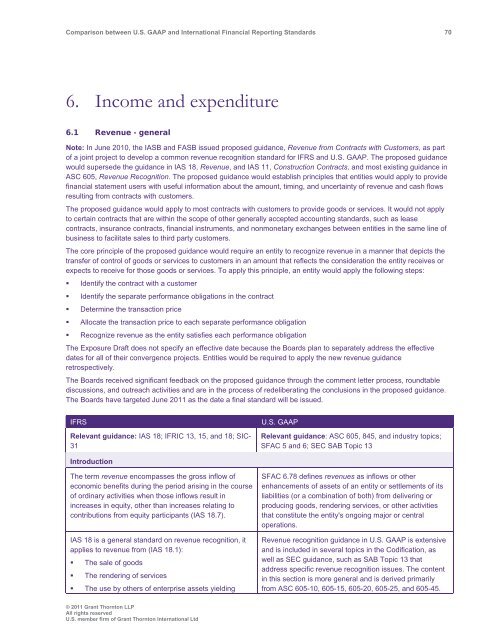Comparison between U.S. GAAP and International ... - Grant Thornton
Comparison between U.S. GAAP and International ... - Grant Thornton
Comparison between U.S. GAAP and International ... - Grant Thornton
Create successful ePaper yourself
Turn your PDF publications into a flip-book with our unique Google optimized e-Paper software.
<strong>Comparison</strong> <strong>between</strong> U.S. <strong>GAAP</strong> <strong>and</strong> <strong>International</strong> Financial Reporting St<strong>and</strong>ards 70<br />
6. Income <strong>and</strong> expenditure<br />
6.1 Revenue - general<br />
Note: In June 2010, the IASB <strong>and</strong> FASB issued proposed guidance, Revenue from Contracts with Customers, as part<br />
of a joint project to develop a common revenue recognition st<strong>and</strong>ard for IFRS <strong>and</strong> U.S. <strong>GAAP</strong>. The proposed guidance<br />
would supersede the guidance in IAS 18, Revenue, <strong>and</strong> IAS 11, Construction Contracts, <strong>and</strong> most existing guidance in<br />
ASC 605, Revenue Recognition. The proposed guidance would establish principles that entities would apply to provide<br />
financial statement users with useful information about the amount, timing, <strong>and</strong> uncertainty of revenue <strong>and</strong> cash flows<br />
resulting from contracts with customers.<br />
The proposed guidance would apply to most contracts with customers to provide goods or services. It would not apply<br />
to certain contracts that are within the scope of other generally accepted accounting st<strong>and</strong>ards, such as lease<br />
contracts, insurance contracts, financial instruments, <strong>and</strong> nonmonetary exchanges <strong>between</strong> entities in the same line of<br />
business to facilitate sales to third party customers.<br />
The core principle of the proposed guidance would require an entity to recognize revenue in a manner that depicts the<br />
transfer of control of goods or services to customers in an amount that reflects the consideration the entity receives or<br />
expects to receive for those goods or services. To apply this principle, an entity would apply the following steps:<br />
• Identify the contract with a customer<br />
• Identify the separate performance obligations in the contract<br />
• Determine the transaction price<br />
• Allocate the transaction price to each separate performance obligation<br />
• Recognize revenue as the entity satisfies each performance obligation<br />
The Exposure Draft does not specify an effective date because the Boards plan to separately address the effective<br />
dates for all of their convergence projects. Entities would be required to apply the new revenue guidance<br />
retrospectively.<br />
The Boards received significant feedback on the proposed guidance through the comment letter process, roundtable<br />
discussions, <strong>and</strong> outreach activities <strong>and</strong> are in the process of redeliberating the conclusions in the proposed guidance.<br />
The Boards have targeted June 2011 as the date a final st<strong>and</strong>ard will be issued.<br />
IFRS<br />
Relevant guidance: IAS 18; IFRIC 13, 15, <strong>and</strong> 18; SIC-<br />
31<br />
U.S. <strong>GAAP</strong><br />
Relevant guidance: ASC 605, 845, <strong>and</strong> industry topics;<br />
SFAC 5 <strong>and</strong> 6; SEC SAB Topic 13<br />
Introduction<br />
The term revenue encompasses the gross inflow of<br />
economic benefits during the period arising in the course<br />
of ordinary activities when those inflows result in<br />
increases in equity, other than increases relating to<br />
contributions from equity participants (IAS 18.7).<br />
IAS 18 is a general st<strong>and</strong>ard on revenue recognition, it<br />
applies to revenue from (IAS 18.1):<br />
• The sale of goods<br />
• The rendering of services<br />
• The use by others of enterprise assets yielding<br />
SFAC 6.78 defines revenues as inflows or other<br />
enhancements of assets of an entity or settlements of its<br />
liabilities (or a combination of both) from delivering or<br />
producing goods, rendering services, or other activities<br />
that constitute the entity's ongoing major or central<br />
operations.<br />
Revenue recognition guidance in U.S. <strong>GAAP</strong> is extensive<br />
<strong>and</strong> is included in several topics in the Codification, as<br />
well as SEC guidance, such as SAB Topic 13 that<br />
address specific revenue recognition issues. The content<br />
in this section is more general <strong>and</strong> is derived primarily<br />
from ASC 605-10, 605-15, 605-20, 605-25, <strong>and</strong> 605-45.<br />
© 2011 <strong>Grant</strong> <strong>Thornton</strong> LLP<br />
All rights reserved<br />
U.S. member firm of <strong>Grant</strong> <strong>Thornton</strong> <strong>International</strong> Ltd
















